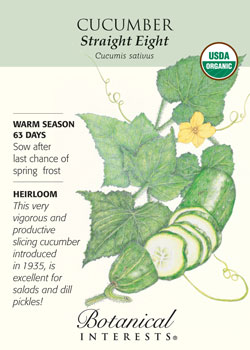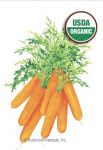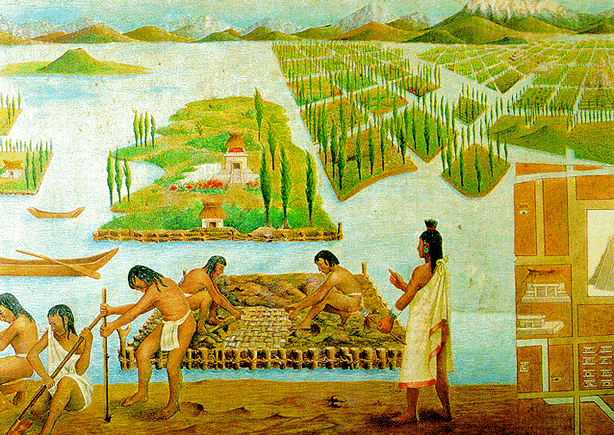
Aztec Reef Hydroponic Gardening
Gardening is an age old occupation. There is evidence that in the Fertile Crescent of the Near and Middle East, people were farming grains and legumes as far back as 8000 BC. In 5000 BC, North American people were inhabiting river bottoms and cultivating crops there. In about 4800 BC, the people of Mexico, Central America, China and West Asia were growing a diverse selection of crops. By 3500 BC the Egyptians were using extensive irrigation techniques and even had garden art.
Of course, people grew gardens for sustenance, to have foods other than those that could be hunted and gathered. Food security could be found in growing food rather than expecting to find it in the wild. As tribes grew bigger and more numerous in various locations, people had to go farther and farther away to find food. Growing food close to home alleviated long, often dangerous treks to find food.
The history goes on and on in culture after culture all over the globe. Peruvians grew potatoes in the Andes in 3000 BC and Egyptians were painting tomb walls with pictures of gardens, fish ponds and fruit trees.
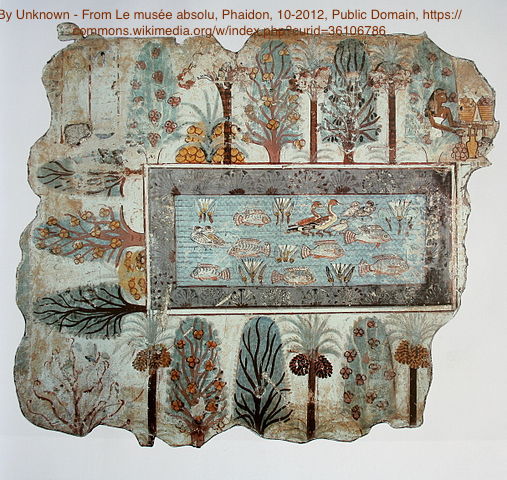
Painting from the tomb of Nebamum in Thebes, Egypt. Circa 1350 BCE
In 1750 BC in Babylon, the Hammurabic Code, the world’s first known written set of laws, included property laws regarding gardens.
Today’s gardener is connected to people far back in history both through gardening and the uses of herbs. Many of the food plants and culinary herbs we use today have been grown and cultivated around the world for centuries.
As early as about 3000 BC. in Mesopotamia (now Iraq) and China there were manuals were written on the uses of herbs as medicine.
At one time, people thought of herbs more as part of the food group than as “seasoning”, as we do today. In very complete herb encyclopedias, such as Encyclopedia of Herbs & Their Uses by Deni Bown many plants that we consider vegetables today are listed as herbs.
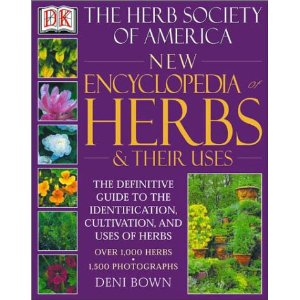
The lowly cucumber, Cucumis sativus, is listed in Culpeper’s The English Physitian Enlarged, 1653, that “there is not a better remedy for ulcers in the bladder” and “the face being washed with their juice, cleanses the skin”.
The seeds are said to expel intestinal parasites. The fruit cools and softens the skin. The fruit will also cool burns, including sunburn and scalds. It is recommended for sore eyes. We know putting cool slices of cucumber on your eyes and resting for a few minutes will reduce bagginess under the eyes. The bitter cucumber, C. colocynthis, is an important homeopathic remedy for colic, according to the Encyclopedia of Herbs and their Uses.
Our common peach, Prunus persica,
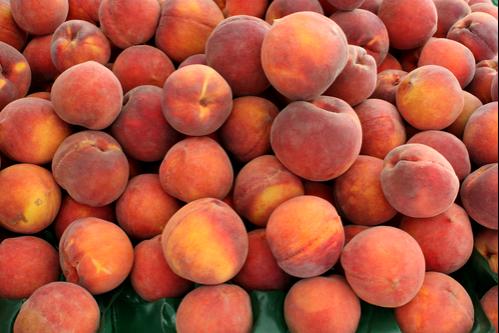
Picture courtesy of Free Food Photos
has many medicinal uses. The leaves and bark contain components that will treat gastritis, coughs, whooping cough and bronchitis. In Chinese Medicine, the leaves are used to treat malaria, boils and eczema. And, the flowers are used to treat coughs, asthma and constipation. The oil is used in skin creams and the fruit to flavor ice cream and candy.
Other varieties of trees in the Prunus family have varied and useful properties that were used by native Americans and the Chinese.

Asparagus
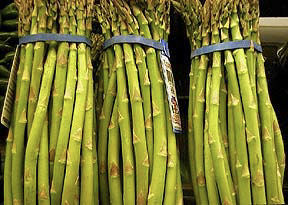
Asparagus- tasty, nutritious and useful!
is a highly regarded herb worldwide. To judge from ancient Egyptian tomb drawings, asparagus was cultivated as long ago as 4000BC. Chinese pharmacists save the best roots of the asparagus plant for their families and friends in the belief that it will increase feelings of compassion and love.
In India, this herb is used to promote fertility, reduce menstrual cramping, and increase milk production in nursing mothers.
In the Western world, it has been touted as an aphrodisiac.
These customs and beliefs are not mere superstition: asparagus root contains compounds called steroidal glycosides that directly affect hormone production and may very well influence emotions.
Asparagus info and picture courtesy of Herbalpedia
We are learning more and more about phytonutrients in food and how they help our body in myriad ways. Herbs also contain phytonutrients, those little bits of nutrients contained in plants that can only be useful when the actual leaf, fruit or vegetable itself is ingested.

In my interactions with people at Markets, I find more and more people are starting gardens. There are experienced gardeners and novices alike who want more control over what they eat, to know how their food is grown and treated after harvest and to have nutritious food at a reasonable cost. Young families want to teach their children about gardening, how food is grown and to give them a better appreciation of what goes on their plate. Food does not originate at the grocery store.
Farmers’ Markets are becoming popular and numerous. People with a little bit of land are growing extra produce and taking what their family doesn’t eat to small Markets. Some are giving up their “day job” and turning to sustainable and intensive small farming to satisfy their own desire to grow food and to produce food to sell to others at markets.
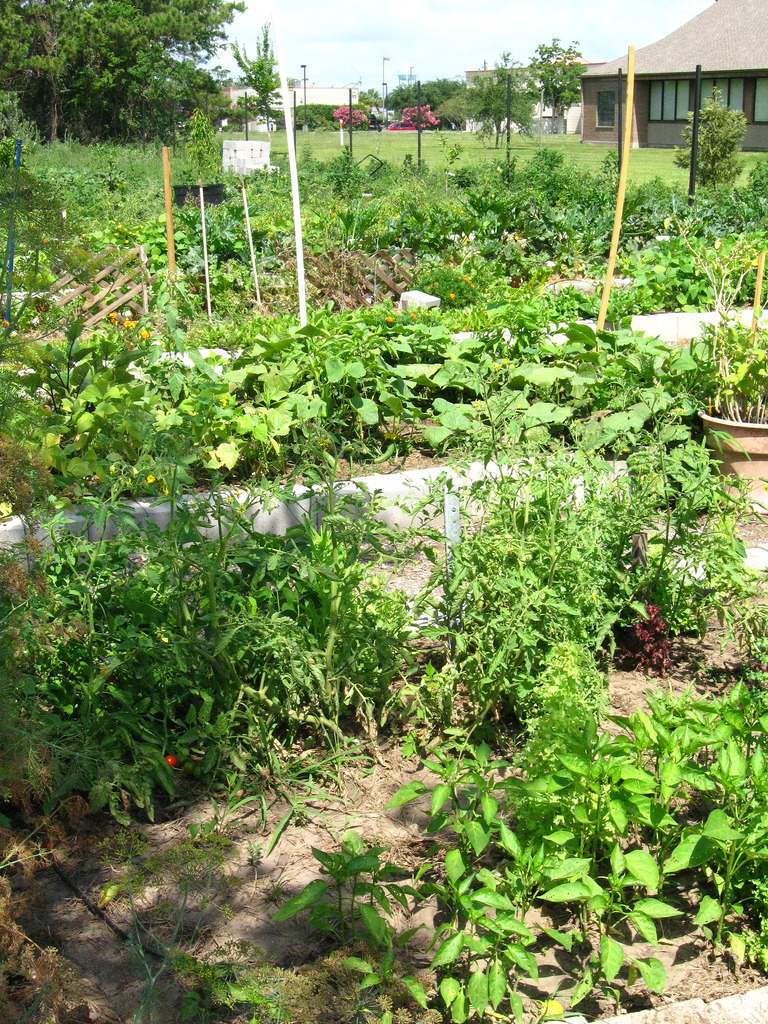
Providence Community Garden in Houston, TX
Urban dwellers with only a small outdoor space are learning to efficiently grow vegetables and herbs in containers. Community gardens abound at churches, schools and in neighborhoods.
Indoor growing with hydroponics and aquaponics is making a huge entry into urban food growing, partly because it can be done in all weather and without worrying about soil contamination from industrial use or air pollution.
Those who don’t have the time or energy to grow their own food still want healthy, locally grown food. We’re finding more locally grown produce, meat, eggs and dairy in our grocery stores.

People are learning about canning and other methods to preserve their hopeful harvest. Communities are holding classes to teach canning, fermenting and other ways to preserve food, since those skills are seldom passed down in modern families.

Preserving food is patriotic!
Workshops for small farmers and would-be small farmers held around Texas and beyond are well-attended by people wanting to learn more about growing for market.
Some people are likening this trend to the Victory Gardens of World Wars I & II, where during WW II, by some accounts, we grew 40% of all produce grown in the U.S. for a few years. Whether we will achieve such a feat or not, the trend for people to become closer to their food source is encouraging.
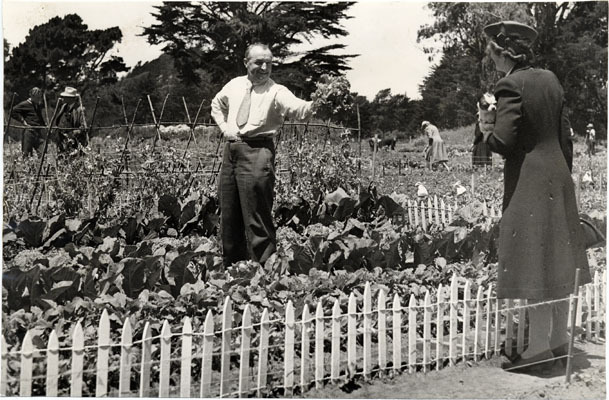
golden gate park victory gardens, 1943 – sfpl historic photograph collection
And, gardening is such a rewarding activity. Even if you only have a single tomato plant or a small group of herbs in containers, there is a great feeling of satisfaction to pick a ripe tomato you’ve grown yourself, slice it and eat it warm from the sun. Or to pluck cherry tomatoes right off the vine and enjoy them in the garden with your children or grandchildren. Growing food helps interest children in new foods, especially vegetables.
Learning to use herbs you’ve grown yourself in teas and other ways adds new flavors to your meals. The feeling of accomplishment is immeasurable. To pass this on to our children is surely a worthy goal.
So, remember, when you’re planning your gardens, make room for lots of vegetables and herbs. Experiment and learn how to cook simply and with fresh ingredients, including fresh herbs. You’ll be healthier and happier for it.

Container grown carrots at The Herb Cottage from these seeds: Baby Finger Carrots. Click on the pic and find them on the website!
QUOTE FOR THE MONTH
Happiness is not a goal; it is a by-product. -Eleanor Roosevelt, diplomat and author (1884-1962)

